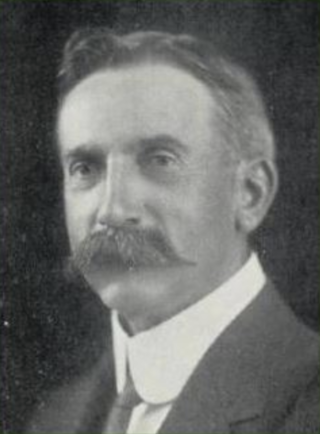
The 1922 Tasmanian state election was held on 10 June 1922 in the Australian state of Tasmania to elect 30 members of the Tasmanian House of Assembly. The election used the Hare-Clark proportional representation system — six members were elected from each of five electorates.

Joshua Thomas Hoskins Whitsitt was an Australian politician. He was a member of the Tasmanian House of Assembly from 1909 to 1922 and a member of the Australian House of Representatives from 1922 to 1925.

Lancelot Thomas Spurr was an Australian politician. He was an Australian Labor Party member of the Australian House of Representatives from 1939 to 1940 and the Tasmanian House of Assembly from 1941 to 1956. He was Speaker of the Tasmanian House of Assembly from 1950 to 1955.
The Centre Party, previously the Country Party, was a minor Australian political party in the state of Tasmania. Initially formed in 1962 as a new Tasmanian branch of the Country Party of Australia after decades of inactivity in the state, it at first enjoyed no electoral success. In the run up to the 1969 election the party was joined by Kevin Lyons, a former Liberal turned independent member of the Assembly for Braddon, who renamed it the Centre Party and retained his seat at the election, securing the balance of power and serving as Deputy Premier in a coalition government until 1972. Upon the coalition's collapse the Centre Party faded away before being dissolved in 1975.
A by-election was held for the Australian House of Representatives seat of Wilmot in Tasmania on 26 February 1904. This was triggered by the death of former Premier of Tasmania and federal Free Trade Party MP Sir Edward Braddon on 2 February 1904.
The Division of Tasmania in Australia was created in 1901 and abolished in 1903.
This is a list of electoral results for the Division of Bass in Australian federal elections from the division's creation in 1903 until the present.
This is a list of electoral results for the Division of Braddon in Australian federal elections from the division's creation in 1955 until the present.
This is a list of electoral results for the Division of Lyons in Australian federal elections from the division's creation in 1984 until the present.
This is a list of electoral results for the Division of Franklin in Australian federal elections from the division's creation in 1903 until the present.
This is a list of electoral results for the Division of Wilmot in Australian federal elections from the division's creation in 1903 until its abolition in 1984.
The following tables show state-by-state results in the Australian Senate at the 1901 federal election. Senators total 17 Free Trade, 11 Protectionist, and eight Labour. The terms were deemed to start on 1 January 1901. In each state, the first three elected received full six-year terms, and the three senators elected with the lowest number of votes retire after three years.

The 2018 Tasmanian state election was held on 3 March 2018 to elect all 25 members of the Tasmanian House of Assembly.

The following tables show state-by-state results in the Australian Senate at the 1996 federal election. Senators total 35 coalition, 29 Labor, two Green, two non-coalition National, seven Democrats, and one Independent. Senator terms are six years, and took their seats from 1 July 1996, except the territories who took their seats immediately.
The Tasmanian Labor Party, officially known as the Australian Labor Party (Tasmanian Branch) and commonly referred to simply as Tasmanian Labor, is the Tasmanian branch of the Australian Labor Party. It has been one of the most successful state Labor parties in Australia in terms of electoral success.

This is a list of electoral division results for the Australian 2007 federal election in the state of Tasmania.

This is a list of electoral division results for the Australian 2004 federal election in the state of Tasmania.

This is a list of electoral division results for the Australian 2001 federal election in the state of Tasmania.
The Australian states each elected three members of the Australian Senate at the 1906 federal election to serve a six-year term starting on 1 January 1907.
This is a list of electoral results for the Australian Senate in Tasmania since Federation in 1901.








